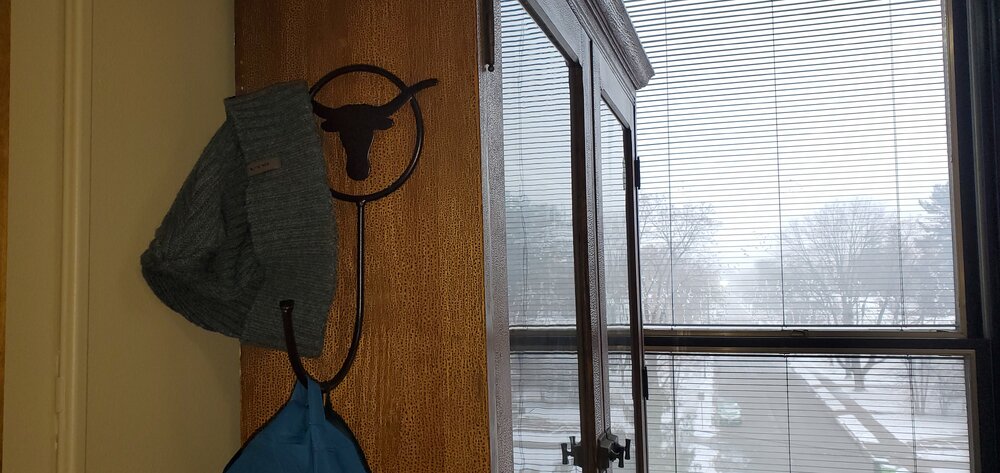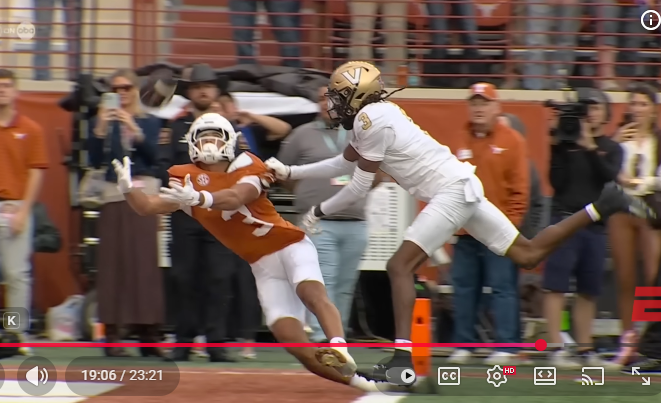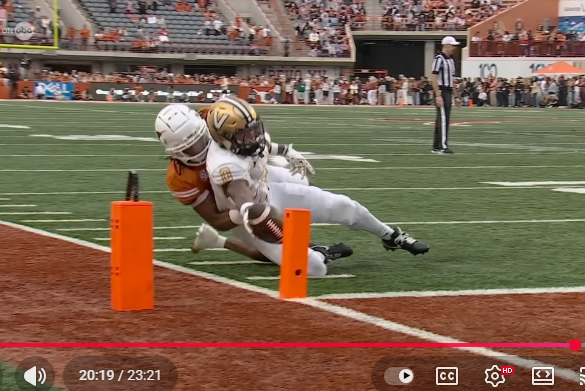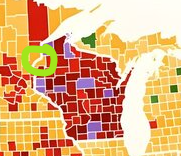-
Posts
470 -
Joined
-
Last visited
Content Type
Profiles
Forums
Store
Downloads
Recruiting - 2020
2019-2020 Football Season
Football
Entertainment
Sports
News and Business
Cloak Room
Transfer Portal
Recruiting
Events
Everything posted by Hayduke
-
From the frozen north woods, where we're not skeered of 45 mph gusts or icy roads, and certainly not A&M ... FIGHT!
-
@MrRogue, can I use the discount in the store? What do I have to do to verify voting there, or do I just mention the code?
-
I'm not seeing a launch there. Just a full-speed hit and a pretty good wrap-up with Smith's head clearly up. Left foot is firmly planted until he goes down with the tackle. Seems like it would be pretty tough not to leave your feet when you've obliterated the guy at speed and have him wrapped up. If there is any launch, it's one-footed and after contact. Does that fit the definition?
-
Waiving your dick will do that pretty much every time.
-
I can see why he might have made it a "just in case it did cross" call, but the videos provided more than enough evidence to overturn it. Yeah, maybe some really, really thick laces that we couldn't see well on camera might have just nicked the plane of the goal line, but at that point, the replay officials should have just said, "Too many gambling arrests and referee suspensions to risk this letting this slide." The end of that game was not a good look and now goes onto the same shelf as the Okie State and Grant Teaff productions. Edit: except this one had the proper happy ending.
-
The link I gave shows pretty much all the plays, including the personal foul against Filsaime on the sideline, which occurs at the 16:00 mark and has multiple replays. Gotta give credit to Pavia on that one. Shrewd MF who manipulated the play into a penalty.
-
Been waiting for this all morning but no one has posted, so here it is. I'm one of those who was cut off from coverage yesterday so I just listened to the game on Sirius XM while working, and these YouTube highlights are the first time I've seen the plays. On the video highlights, it's obvious that the pylon never moves.
- 1592 replies
-
- 10
-

-

-
Logged in just in time to encourage Führich's game-tying shot to bend in right before halftime. You're welcome, @Mittens.
-
All I've seen is this from Alt National Parks saying 22 MAGA types were arrested. I've looked at a few sites but am not gonna spend much time on it this morning. It's pretty clear yesterday went about as peacefully as it could and just about the most horrifying thing coming out of it was Trump's video, which apparently highlighted Harry Sisson as the main recipient of the dumping. But even the Trump video appears to be downplayed by U.S. mainstream media right now -- it was a publication in India where I found an article about Sisson being the target of the Trump dump. https://www.facebook.com/share/p/1CS8aUCfy5/
-
Probably not much to worry about, @Mittens. I've been too distracted to pay much attention at all this season, unfortunately, but every time I do I see I haven't missed a lot. Took a quick peek this morning and saw they were down 2-0 to Leverkusen but haven't checked since. Barely have time to do football today and am gonna have to listen to the Horns on satellite radio on the way to the airport to pick up my wife. Hope you're doing well.
-
-

Charlie Kirk assassinated at an event in Utah (by a 22 YO groyper)
Hayduke replied to msbesq's topic in Cloak Room
"Half the country" probably doesn't even know or use, much less attempt to define, the term "fascist." But I do bet that most people who both use and know the term are also pretty astute at figuring out where most of it sits on the left-to-right American political spectrum right now. But, yeah, sure, his messages will be "that much more popular" among the young voters. Especially those young, black females like the one who got arrested at Tech. -

Charlie Kirk assassinated at an event in Utah (by a 22 YO groyper)
Hayduke replied to msbesq's topic in Cloak Room
Major respect to both your wife and you. I think there are some excellent congregations from many branches of Christianity out there, and they tend to self-select. The Catholic church over near campus has very different homilies from its priest and very different programs than the others in town. Although we almost always attend the churches closest to the house, my wife is deeply involved in a different one that does all the work with Hispanics in the community, so I'm careful about my actions. I would suspect local Hispanic congregants would respond differently to the homily we heard yesterday -- assuming that at least a few of them had a clear understanding of Kirk and had the opportunity to discuss it. But that's a big assumption, as a good majority of them are too busy working to keep trades, restaurants and farms running around here, whether they own the businesses or simply work a lot. They're aware of a small number of ICE incidents that have impacted the larger Hispanic community here, but generally, ICE has focused its attention on different parts of the country so far. -

Charlie Kirk assassinated at an event in Utah (by a 22 YO groyper)
Hayduke replied to msbesq's topic in Cloak Room
Ah ... I am suddenly viewing all of my students in a new light and gaining appreciation for their organizational leadership skills. 😆 -

Charlie Kirk assassinated at an event in Utah (by a 22 YO groyper)
Hayduke replied to msbesq's topic in Cloak Room
Gave it some thought, didn't act immediately, and that was probably good. Fairly certain it wouldn't be very effective compared to other approaches, which I'm thinking about a lot right now. Grown son (but young and in military) said he would have said something. Good that he wasn't there. We're going to need him and other thoughtful, moral and upright leaders in the military if stuff keeps moving in the current direction, but he'd probably not be in that position if he draws attention to any of his political statements. -

Charlie Kirk assassinated at an event in Utah (by a 22 YO groyper)
Hayduke replied to msbesq's topic in Cloak Room
I attend Mass for my family's sake. There's a balancing act for me, and a lot of cognitive dissonance. Today the priest, in his homily, drew parallels between Kirk and Saint Maximilian Kolbe, the subject of a current movie that's essentially one of those church-promoted, independently produced films that survive because of crowdfunding Christians. The priest's description of Kirk was basically that he was only a guy trying to bring civil, open discourse to society, that he was a father and a family man. This in a university town where many understand Kirk got wealthy by going after faculty on his Professor Watchlist. It was, to me, indicative of where much of the more conservative side of the Catholic church is heading. Eventually that will probably cause more serious issues in our family, as it may in society at large. The priest's homily was disgusting. The lack of any apparent response from the sheep in the congregation was disturbing and a little scary. The Catholics, however, are less scary to me now than the worst of the evangelicals, the "seven mountain" folks and others. It appears Kirk's wife is a Catholic who likely will return more fully to the fold, although maybe she goes in some other direction. Regardless, I see difficulty for her in carrying out the work of a husband who reinforced the notion that women need to stay in their place. Can't imagine she'll have nearly the following, but they apparently are worth about $12 million and somebody else will probably fill that mindless void. And no matter what happens there, the bigger issues are getting closer and closer to tearing the rest of our country into some pieces that will not be easy to put back together. -
Just a subtle flag tribute from some Ethiopian graphic artist. But, yeah chart is misleading the way it is. The color scheme confuses matters. Other than being at the top of very different conferences, there's no similarity between K-State and Texas, or Utah and Alabama. Turns out there are 14 flags with the green-yellow-red combo of bars/columns/blocks, but none except this Ethiopia do the G-Y-R horizontal order. Unless the chart was done by a Colombian trying to diss the Bolivians, whose flag is red-yellow-green from the top.
-
Guilty, but not with the margs -- on the lemonade-and-beer end. My wife bought a bunch of Pacifico and some other lighter stuff for a gathering we had this summer. It had been a while since I had the Pacifico and my tastes have changed enough that I am no longer as impressed as when I first had it in Austin many years ago. So I thought -- since we were frequently try different shandies in the summer -- that I'd make my own lemon shandy. Bought what I thought was some good lemonade and made my own shandy. It sucked, but mostly because it turned out I missed an old sell-by date on the lemonade (took it back to the store because it made me waste a perfectly fine Pacifico). To make up for it I'm gonna go find some Leinie's or Shiner if we get some more summer up here. The Shiner Lemonade Shandy, BTW, is outstanding, for those who accept shandies as legit.
-
Eh. imma was complaining somewhere that we don't even have anything to argue about, which is pretty funny when you think about it. Call it trolling or call it debate. Keeps the board rolling along, and sometimes it's worth the read, even if just to see whether anyone is changing their mind or if new info has come to light. Like most Texas fans, I'm probably never going to buy the argument that Texas was acting in a way that was more self-interested than the majority of the other schools, if not all of them. To me, it's a pretty simple logic: UT could always afford to act in the common interest and did for a number of reasons -- especially to keep its athletes competing regionally instead of further afield. But anyone who's ever acted that way, in any endeavor, can quickly learn that acting in the common interest often costs yourself too much. There comes a point where you just have to say, "Every man for himself, then. I tried." Hell, that's my life in higher ed in a nutshell. I remember being in Costa Rica the summer the Big XII was really trying to survive and meeting several fans from other conference schools, each of whom gave some pretty convincing lip service to the idea that they were grateful for Texas' efforts to hold the conference together.
-
When you pick the most obvious topic for punny references, you've got to rise above the crowd. Keep working on it. It's a pretty steep hill that you've come upon.
-
So what you're saying is that each one of those wood chips is a Surly poster.
-

Can we talk about Alabama and Michigan and objectivity?
Hayduke replied to BluTechsan's topic in Football
Well, there's your problem. You're trying to understand something that has, since its inception, been subjective, at least partly illogical and always lacking in enough data. Even on-field results are arguably "subjective" in a game where officiating can play a huge role, as can all sorts of other circumstances. It's played by humans, who are remarkably consistent in their inconsistency. That's just sport. Also -- though I generally like Tech compared to most of, for instance, our original Big XII conference mates -- I have to say that "beating their drumb" in your OP is one of the most spectacular Freudian slips on Surly in recent memory. Thanks for that, @BluTechsan. 😆 -

Texas Football 2025 - Seven Win Steve Rides Again
Hayduke replied to closetojumping's topic in Football
Fire Sark. He is literally shitting away the National Narrative Championship. Well, maybe figuratively. But y'all know what I mean.
Football ... Basketball ... Baseball ... Other Sports ... Futbol ... 🤫995🤫 ... Gambling ... Movies & TV ... Music ... Hobbies ... Lulz ... Food & Travel ... Daily Texan ... Business and Markets ... Cloak Room ... Help ... For Sale ... Board Discussion ... Subscribe!... Donate!... COOKIE MONSTER!








